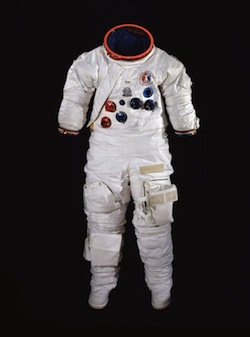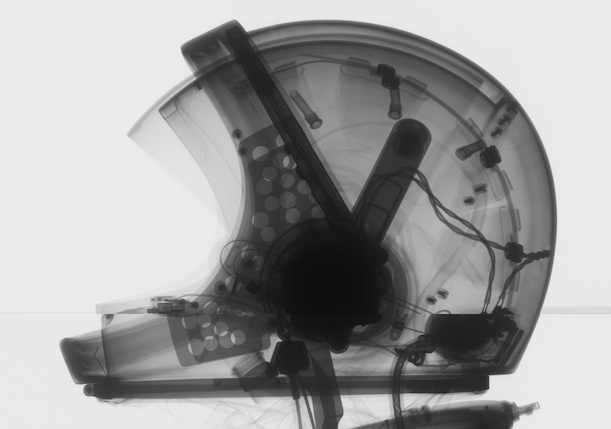The Evolution of the Spacesuit
The traveling exhibition “Suited for Space” depicts spacesuits through the ages
This 1964 A4-H “Universal” helmet could fit on more than one suit. The X-ray reveals ball bearings in the neck ring that allowed the helmet to move right and left without restriction. Image and caption courtesy of Air and Space Museum
Smithsonian’s traveling exhibition “Suited for Space” came home last week, joining two art shows, “High Art: A Decade of Collecting” and “Searching for Goldilocks,” in the Air and Space Museum’s Flight and the Arts Gallery. “Suited for Space,” which has been touring the country with the Smithsonian Institution Traveling Exhibition Service (SITES) since 2011, illustrates the evolution of spacesuit technology from the early 20th century until the dawn of the shuttle era.

Astronaut Alan Bean wore this A7-LB suit on the 1973 Skylab 3 mission. Image and caption courtesy of Air and Space Museum
The exhibit features large-scale photographs of spacesuits through the ages, conveying a “visual timeline” of their development in addition to each suit’s unique “personality,” according to curator Cathy Lewis. X-ray footage reveals the suits’ internal intricacy, including numerous joints, rings and ball bearings for flexibility.
Visitors will discover a remarkable range of designs, from the famous suits of Alan Bean and Buzz Aldrin to experimental prototypes that look straight out of science fiction. Lewis considers the suits works of art. “They’re creative products,” she says. “When you’re talking about spacesuits, you have certain principles and functions that you have to follow, and the artistry is in the varying and divergent ways that engineers have approached the same problems.” Spacesuits must strike a balance between providing airtight protection—against radiation, extreme temperatures, contamination and more—and providing maximum mobility for the wearer.
Spacesuits are not, however, built to last. Designed to withstand extreme conditions for short periods of time, these “wearable spacecraft” are too fragile to travel. While “Suited for Space” features no real spacesuits, it does contain a replica Apollo suit and several spacesuit accessories from the Air and Space Museum’s collection, including a glove, a boot and a “fecal collection assembly,” answering the perennial question of how astronauts go to the bathroom in space.
